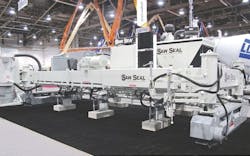Saw Seal Machine
Concrete paving projects typically employ a “paving train,” with a placer/spreader heading the way, then the slip-form paver, followed by the texture/cure machine. But John Mueller, president and CEO of Saw Seal Inc., says that his company’s new Saw Seal Machine (SSM) has the potential to become a standard addition at the end of the train. The SSM automates the process of sawing, cleaning, and sealing joints—making cuts with as many as seven longitudinal and four transverse saws, vacuuming and capturing dust from the cuts, and applying hot sealant in just the right amount.
The SSM, which made its first public appearance at World of Concrete 2014, is designed to span the width of the pavement (up to 50 feet), making contact with the fresh concrete only with its saw blades. The blades are hydraulically driven, completely enclosed with a protective guard to assist dust collection, and equipped with spring-loaded skid plates that apply pressure at the cut to minimize pavement raveling.
The limited-contact design of the SSM, says Mueller, allows joint sawing to commence much sooner, compared with having to wait until the pavement can support a crew with conventional saws.
Each individual sawing unit is fitted with a vacuum system, compressed-air nozzle, and a sealant applicator. Dedicated hoses remove dust from the cut via a HEPA (High-Efficiency Particulate Absorption) filtration/vacuum system. Dust is stored in a 55-gallon drum, and integral hydraulic arms assist in removing full drums.
To further clean and dry the cut, the compressed-air nozzle is placed immediately behind the vacuum hose. Last, an electronically controlled dispensing system applies the hot sealant, based on the SSM’s travel speed and dimensions of the joint. Sealing production is designed to reach 25,000 linear feet per 10-hour shift.
In standard trim, the SSM uses three longitudinal saws, which can be adjusted to match joint spacing, and two transverse saws mounted on a rack at the front of the machine. Each transverse saw moves along the rack to cut halfway across the pavement, thus the two saws working in tandem complete the joint. The SSM potentially can be equipped with seven longitudinal saws and, with the addition of a transverse rack at the rear of the machine, four transverse saws.
In operation, transverse joints are cut first, then the machine backs up and cuts longitudinally. According to Mueller, precise depth controls allow the saws to handle complex crowning and slope variances.
Standard-width configurations (between the tracks) of the two available models—SSM 900 and SSM 1200—are 27 and 37 feet, respectively. Each frame can be extended with inserts, however. The machines are propelled via a hydrostatic drive system, use rubber tracks, and are steered by following a string line or using the edge of the pavement as a reference. “String-less” technology is being investigated.
The potential benefits of the SSM, says Mueller, include a 50-percent reduction in labor costs, reduced road closures, and precise, consistent cuts that are optimally sealed.
